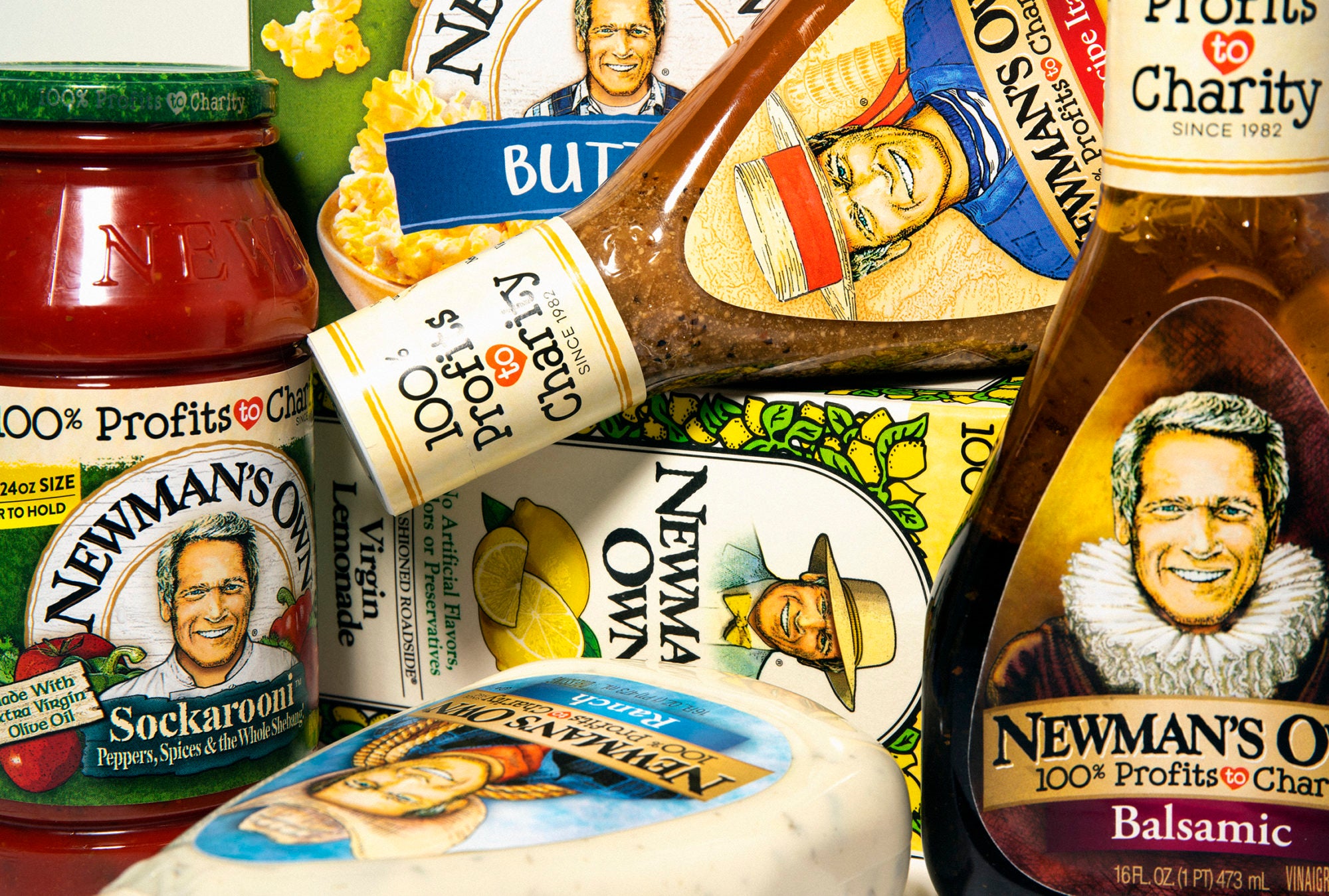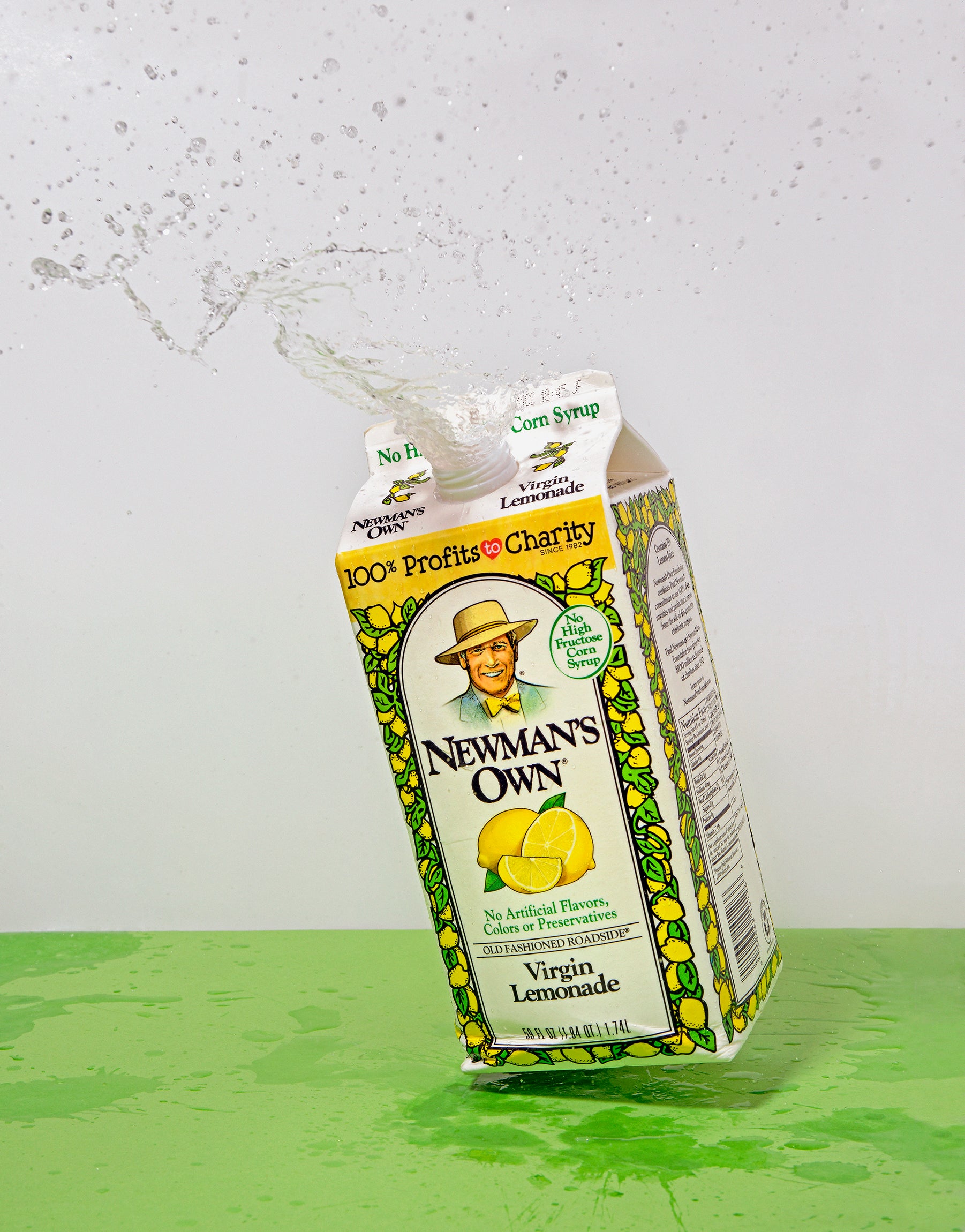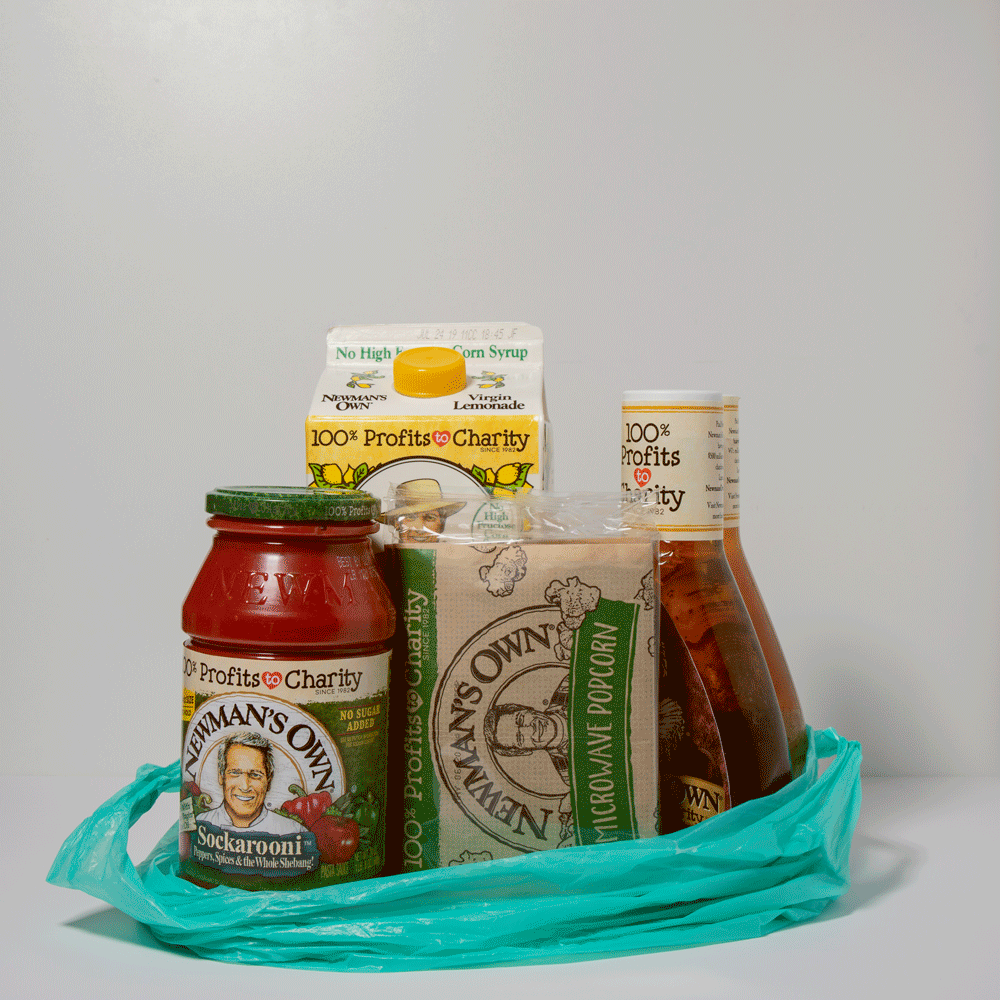
Reassessing the pioneering food brand Newman’s Own and the more than $500 million donated to charity.
What is Cool Hand Luke doing on jars of salsa in the cooler? What’s a Hustler or hitman have to do with homemade salad dressing? It’s a face in freezer aisles and on microwave popcorn in supermarkets everywhere. At the pet store, I grab for Paul Newman without thinking about Paul Newman. My picky-eating dog merely sniffs at some bags of dog treats, but he barks for the silver fox.
How did Paul Newman take over our fridges, cupboards, pasta nights, microwave pizza nights, Oreos, and lemonade cartons? Why did an actor best known for playing misfits and ne’er-do-wells like Butch Cassidy turn his attention to food? And what went so right for this brand that it’s currently sold in 14 countries, with some 280 unique products across 16 food, beverage, and pet food categories?
“Paul was just not a planned guy. He had great intuitions, but he wasn’t a businessman,” recalls Robert Forrester, a longtime friend of Newman and the current CEO and president of Newman’s Own Foundation, which owns and operates Newman’s Own, Inc., the food brand.
Launched in 1982 with a single product, a salad dressing, the brand exceeded expectations, making hundreds of thousands of dollars in profits in its first year. Newman decided to give it all away to charity and to continue doing that for every product that was later introduced, while taking no salary, according to tax filings and the Newman’s Own Foundation. To date, the brand has given away more than $540 million to charity organizations around the world.
Today, a mission-driven brand backed by celebrity power isn’t novel, even in the grocery store—think Rachael Ray’s Nutrish or Oprah’s O That’s Good brand, which donate a portion of proceeds to charity. But Newman’s Own gives “100% Profits to Charity,” which is now displayed on every package almost as prominently as that famous blue-eyed, silver-haired face, as illustrated by the artist Ellen Griesedieck.
Having his face on the label was the part of the project that Newman was least excited about, according to Forrester. Yet, he says, “Clearly having him associated with it, not just associated but having his face on the label, it really helped to get someone to buy it for the first time.”
For an actor who’s been dead for more than a decade now, it’s worth examining why this name, this face—and not Oprah’s—continues to have such a presence in our home kitchens. Was it just all too easy to slap a handsome, white male actor’s face on a jar and watch it sell like hotcakes? And were all these food products really his “own”?
The products are actually manufactured by about 20 copacking partners, some of which have been doing so since their beginning. But Forrester says Newman was personally involved in the development of every new product launch up until his death in 2008, including perfecting the crust of the frozen pizzas. “He would show up and just have an idea,” says Forrester.
“He had this innate sense of rightness about everything, and once he had information about something he was either compelled to wonderfully explode a good idea or to stand in the way and stop something that he could not stand. And that’s just how he was.” This according to Michel Nischan, a four-time James Beard Award–winning chef, sustainable-food leader, and the founder of the nonprofit Wholesome Wave, who partnered with Newman on a restaurant in Westport, Connecticut, called the Dressing Room (it’s now closed) and considered Newman a friend.
But was Paul Newman a foodie? “He had an amazing palate,” says Forrester. “He liked stuff from the garden. He never talked down other food; he just thought the best foods you can find were the least processed.” He recalls Newman and Forrester’s wife talking at length about how to dry out corn kernels to make them perfect for popping. Nischan agrees that Newman had an “uncanny palate” and says he was always curious about food, but that he was always open to changing his ways based on what he’d learned. Many changes came at the insistence of Newman’s daughter, Nell, who convinced him to start selling organic food, as well as to make other changes throughout the product line in the name of environmental sustainability.
“Nell would be like, ‘For your Newman-O’s cookies, you’re using palm oil from Nicaragua, and to have cheap palm oil, they’re endangering orangutans,’” Nischan says. So Newman would switch to a different supplier of oil, in Costa Rica.
Nell Newman, a prominent philanthropist and sustainable-food leader herself, founded the Newman’s Own Organics brand, a subsidiary of Newman’s Own, in 1993. The organic product line has since rolled under the same management, and Nell has not been with the company since 2014. But Nell spoke to me about her family’s love of food and shared the origin story of the famous dressing that started it all.
It’s hard to imagine a Hollywood actor whose heyday was the 1960s and ’70s rolling his sleeves up in the kitchen to roast a Thanksgiving or Christmas turkey, grilling burgers, or perfecting a salad dressing, but that’s just what he did, says Nell.
“They loved cooking at home,” she remembers of her parents, Paul Newman and Joanne Woodward. “We always had big family meals.” She recalls everyone having a job when the family made burgers—one person buttering the rolls, another shucking the corn, and so on, and her father would fix a tiny fan to the grill to get the charcoal going.
“Dad would never let us do fast food, so we did a lot of grilling,” says Nell. They would buy all their produce from a local farm stand. “He taught all of us, you know, the hollow sound of a ripe watermelon and the smell of a good apple.”
According to company legend, Newman’s Own started when Newman and his friend, A. H. Hochner, bottled a huge batch of homemade salad dressing into wine bottles in 1980 to give away to friends. The praise was so overwhelming that they were convinced to sell it to the public; this was recalled in a book about the famous friends, Shameless Exploitation in Pursuit of the Common Good by Nan A. Talese.
Nell confirms this story, but adds that her father became enthralled by the salad dressing made by the now-shuttered New York City restaurant Mme. Romaine de Lyon, a quaint French restaurant specializing in omelets. Nell says she and her family lived in the city until she was about five, but kept an apartment there and went to this restaurant once or twice a week. Of the namesake restaurateur, Nell says, “She was such a character,” estimating de Lyon was probably in her 70s or 80s when Nell’s family frequented the restaurant when she was a child, in the mid to late 1960s.
The restaurant was filled with ladies with “blue and pink hair sitting in the front room,” and its walls were plastered with autographed head shots of Hollywood movie stars. The café only served salad, baked goods like croissants and eclairs, and pages of classic French omelets, which Mme. Romaine made fresh to order. As Nell recalls, the simple salad, and its dressing, was a highlight: “It was just a small bowl of really crispy torn romaine with this piquant salad dressing…and it just primed your palate for omelets.”
In a photo of the restaurant’s menu, the salad is said to be served with “Mme. Romaine’s finest dressing.” Nell recalls that her father kept asking Mme. Romaine for its recipe, but she wasn’t interested in giving it away—until one day, Newman showed up with an autographed head shot each of himself and Woodward, and the recipe exchange was made.
It was the simplest recipe, only olive oil, red wine vinegar, Dijon mustard, salt, and pepper. (In her 1963 cookbook, The Art of Cooking Omelettes, de Lyon provides a recipe for this salad dressing, writing, “A French salad dressing is usually made with dry mustard, but I do not use it, and that probably accounts for the different taste.”) Nell says her father continued to tweak it to make it his own. She has a theory on what made her father’s famous “own” formula: a secret ingredient, celery seeds. “I’m pretty sure Dad came up with the idea of celery seeds after not finding salt in the kitchen, so that had to suffice,” she says, referring to celery salt, a common seasoning that is a mixture of ground celery seeds with salt.
Nell says she used to have a note with her father’s formula for dressing but has since lost it. She estimates it’s about 12 ounces of olive oil, a tablespoon of Dijon mustard, 4 ounces vinegar, then a “huge amount of salt” (one to two tablespoons), a lot of pepper (about half a tablespoon), “because he loved pepper,” and then about a teaspoon of celery seeds. She makes her own versions, often using balsamic vinegar instead of or in combination with red wine vinegar, which her father would find too sweet. And she still makes her dad’s dressing as a seasoning for salads and vegetables, like artichokes. Her father, on the other hand, “used it for all sorts of crazy things. He used it to marinate fish. I remember it was good but was sort of unusual. He was definitely a pioneer when it came to food things.”
In the early ’80s, when Newman’s Own debuted, most salad dressings in the supermarket were pastel orange or white, olive oil was esoteric, and “natural”—or however you wanted to put it—wasn’t a huge selling point. Neither was philanthropy. But nowadays, you will see plenty of food brands using charitable donations as a key ingredient in marketing, like Kind Bar, Good Spread, Love With Food, Endangered Species chocolate, the Soulfull Project, and even less subtly, This Bar Saves Lives. With a growing list of language like “organic,” “fair trade,” and “local” on food labels, grocery shopping has become a minefield of moral dilemmas—and the pantry has become a pantheon to those decisions.
With its combination of pure and natural food values and a purpose-driven mission, Newman’s Own as a brand is right in sync with consumer demands of the times. But Nell says her father never wanted to donate to charity in a loud way. When the label launched, “He made around $900,000, and he was at the peak of his career, and he felt really guilty, so he just decided to give it all away,” she says, describing his brand of “quiet philanthropy.”
This might run contrary to more recent efforts from Forrester to make “more of a show of its record of magnanimity,” according to a 2016 New York Times article. And a 2015 article in Vanity Fair cast doubt on whether the Forrester-run foundation is in keeping with the wishes of Newman and his family. Because isn’t any marketing spending cutting directly into profits that would otherwise have gone to charity? I ask Forrester.
“That’s what’s keeping me awake because we have such a commitment to our charities. Some of them have been with us for such a long time,” he says, citing Serious Fun Children’s Network, a network of 30 camps and programs around the world founded by Paul Newman. “So we’re heartbroken to cut that back to invest in the company, but at the same time we have to invest.”
Forrester says that even if Newman’s Own, which employs just 60 people full-time, were to increase its advertising budget tenfold it would still be a “blip” compared to those of conglomerates like Nestle and PepsiCo. He says Newman’s Own has whittled down its SKUs (industry parlance for line of products) to focus on five core product categories, and that balancing competitiveness in today’s market with figuring out ways to benefit its grantees, and bring more on, is very much on its agenda.
“This is our heart—it’s not like we’re running our philanthropy out of our marketing department. They’re our associates,” says Forrester of the charities they work with. “So my promise to Paul was, if you go before I go and you come back in the room 10 years from now, we’ll still be here and it’ll feel right.”
As a child of the ’80s, Newman’s Own pasta sauces were a once-or-twice-a-week staple in my diet. It was simply the only brand that my parents—neither of them Italian but both incredibly opinionated about matters of taste—could agree on. The “Sockarooni” pasta sauce—a chunky blend with “peppers, spices and the whole shebang!”—was on constant repeat in our kitchen and seemed to smile back at me every time I opened the fridge. Back then, I knew nothing about Newman’s celebrity, nor, actually, the brand’s charitable cause. It’s a household brand of more than 30 years with so many products, and I can’t think of any one of them that’s something to write home about—it’s no longer known for excelling in any one food or category, like salad dressing.
But my dog might think otherwise. When he’s been a good boy or runs back to me in the dog park, there’s no other kind of treat that gets him as riled up as a chewy Newman’s Own beef jerky. As he happily gobbles it up, I’d like to think that other scruffy rescue animals like him might benefit, too, from his snack.

